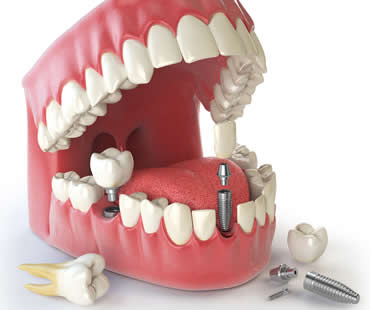
Nov 9, 2023 | Dental Topics 2, Implant Dentistry, Blog
Are you missing one or more teeth? Dental implants are among the best possible solutions for patients missing teeth. Dental bridges and dentures can fill the gaps left by acute decay or gingivitis, but dental implants have many advantages over these other techniques.
Dental implants are typically made of titanium and serve as an artificial root for a missing tooth. They are fused directly to the jawbone and become an excellent foundation for replacement teeth. They are the best possible substitute for a natural tooth that a dentist can provide.
Dental implant therapy has several benefits, among them:
- Dental implants are very convenient. Bridges necessitate cleaning carefully under and surrounding the bridged tooth, and dentures need to be removed and specially cleaned and can utilize messy adhesives to affix them to your mouth. Dental implants are cleaned exactly as you would clean your natural tooth. Brush and floss normally. There is no slippage or cleaning beneath or between the replacement tooth, which is permanently attached to the gum via the dental implant, which fuses to the bone in a process known as ossification.
- Dental implants look better than other replacement teeth. They are intended to appear and function as your natural tooth would.
- Because they’re fused to your bone, they are more secure than dentures or bridges that can slip in the oral cavity, causing pain, muddled speech and problems eating or drinking. Dental implants are incapable of slippage, leaving you to lead your life with confidence and security.
- Dental implants preserve bone by stimulating the bone in your jaw, something necessary for the health of the bone. Without this stimulation, the bone can begin to shrink.
- Dental implants are very durable and can last for decades, if not for a lifetime, when cared for properly.
- Because dental implants don’t require any alterations to the surrounding teeth, those natural teeth are able to remain intact, lending to your overall good oral health.
Our dental office is located in Central Falls

Feb 29, 2024 | Dental Topics 2, Implant Dentistry, Blog
By all accounts, missing teeth negatively impacts a person’s quality of life. Smiling, laughing, eating and speaking just aren’t the same when there are holes left by teeth that used to be there. Instead of going through life with missing teeth or uncomfortable dentures, consider the cutting-edge option of dental implants.
An increasingly popular restoration, dental implants are one of the most requested procedures in dentistry. They involve surgically inserting a titanium post directly into the jaw so that it fuses with the bone in a process called osseointegration. Once the area has healed, an artificial tooth is placed on top of the titanium post to provide a fully functional and aesthetically pleasing new tooth.
One of the reasons for the success of dental implants is that they have the edge over the other options because of the benefits. They provide a very long-lasting, durable solution because they literally will last your entire life with proper hygiene and checkups. Implants are a one-time investment in your smile.
Implants do not negatively affect other teeth since placement doesn’t tamper with adjacent teeth. Implants are good for your jawbone because bones require stimulation to maintain strength and density. Your facial structure also benefits when you have a complete set of teeth, instead of ending up with a saggy, unsupported looking face.
Dental implants are both convenient and comfortable. No special care is required, such as with dentures, because normal brushing and flossing is all that’s needed. Implants are securely in place in your mouth and become part of your body; you won’t even realize you have them. You’ll also be able to continue eating the foods you love since no diet restrictions are necessary with implants.
Another great thing about dental implants is they help boost your self-esteem. You’ll enjoy a whole new level of confidence when you can smile, laugh, talk and eat without worrying about missing teeth. If you choose to get dental implants, you can expect your quality of life to improve.
We treat patients from Central Falls and the surrounding area

Dec 7, 2023 | Dental Topics 2, Implant Dentistry, Blog
Dental implants have become the standard of care recommended by dentists for replacing missing or damaged teeth. Compared to other solutions, many patients are finding that dental implants give them a reason to smile.
Realism:
Dental implants provide a new tooth and root that looks, fits, functions, and feel like a natural tooth. Implants avoid the potential problems associated with some alternatives, such as trouble eating, speaking or laughing.
Durability:
Dental implants can last a lifetime with proper care, making them outlast most of their counterparts which have a lifespan of up to 10 years.
Natural:
Patients are able to retain their natural face shape. Missing teeth can make a person’s face look sunken and saggy, but implants allow you to maintain your proper face shape and smile.
Protective:
Missing teeth may cause jaw bone deterioration or loss, but implants preserve and stimulate the natural bone. The jaw is able to maintain its strength and firmness, protecting your bone structure. Also, neighboring teeth are not affected by dental implants. Healthy adjacent teeth are not damaged and stay exactly where they should be.
Health:
Cavities can’t take hold in a dental implant and crown. Proper hygiene and regular checkups should continue to ensure your mouth is healthy, but that particular tooth will not decay.
Confidence:
Dental implants erase the patient’s embarrassment about their smile and give them the confidence to enjoy life again. No more worries about a big space in the smile, and no concerns that the restoration will loosen or fall out like may happen with dentures.
Convenience:
There are no hassles for the patient to alter their diet because implants allow natural biting and chewing. Favorite foods can still be enjoyed with this restoration.
If you need a dentist in Central Falls contact us today

Oct 2, 2020 | Dental Topics 2, General Dentistry, Blog
Maintaining a healthy, winning smile is easy with the help of general dentistry. People have all kinds of excuses for avoiding dental checkups. Don’t have the time? Advancements in procedures make treatment faster and more efficient, and extended hours allow patients to better fit appointments in their schedules. Too expensive? Many procedures are reasonably priced and most offices offer financial plans. Afraid of the dentist? General dentistry offers options for maintaining patient comfort and minimizing pain.
Once you realize there is no good excuse for skipping dental treatment, you should go for checkups twice a year for optimum care. Prevention is often the key to having the best oral health. Routine checkups identify early warning signs of issues like tooth decay or gum disease, so that problems can be corrected before becoming severe. Thorough examinations, diagnostic tests like X-rays, and regular professional cleanings are all steps to a healthy smile.
General dentists also teach proper hygiene methods so that you can keep your mouth in good shape between checkups. Routine dental care also may prevent harmful bacteria from entering your bloodstream and damaging other parts of your body.
If problems are diagnosed when you visit your dentist, various treatments can be performed to restore your oral health. General dentists treat all kinds of issues and typically offer dental fillings, root canal therapy, extractions, bonding, crowns, dentures and more. If there are procedures that you need that your general dentist doesn’t perform or would prefer you visit a specialist for advanced treatment, you’ll be referred to a qualified and experienced doctor.
General dentistry can make the difference between a dull, damaged, unhealthy smile and one that will look nice and function well for the rest of your life. Don’t hesitate in visiting your dentist regularly for optimum oral health.
We look forward to seeing you in our Central Falls dental office

Aug 31, 2018 | Dental Topics 2, General Dentistry, Blog
The fact is that the health care provider most people should see the most is their general dentist. Because this branch of healthcare is uniquely targeted at preventing disease and promoting good hygiene, general dentistry can help you avoid oral concerns and maintain a healthy and attractive smile.
General dentists are the most common providers for dental treatment for patients of all ages. Routine dental visits involve examinations, sometimes diagnostic tests, professional cleanings, and discussions about concerns. If your checkup reveals issues that require further treatment, most general dentists perform required procedures. However, your general dentist may refer you to a specialist for complex treatments.
What does a general dentist do? Differing from specialists who focus on a certain area of oral care, general dentists offer a wide variety of services.
- Preventive services – The goal of preventive dentistry is to stop disease before it has a chance to progress. Regular exams, diagnostic images, and professional cleanings are part of prevention. Proper oral hygiene techniques will also be discussed.
- Restorative services – Procedures for dental problems falls into this category, including fillings, crowns, gum disease remedies, dentures and more. Some general dentists also offer specialized treatments like root canal therapy and dental implants.
- Overall oral health services – Some dental problems are reflected in overall health concerns. Diabetes, cardiovascular disease, pregnancy complications and other problems may arise. General dentists can identify issues like these and offer treatment or direct you to the right specialist.
- Cosmetic services – Many general dentists offer cosmetic treatments such as dental veneers, teeth whitening, bonding, orthodontics and more.
When should you visit your general dentist? Experts recommend getting checkups every six months, or more often if you have an issue that should be addressed like a toothache or gum bleeding. Cosmetic appointments can be made at any time. The main thing is seeing your general dentist regularly so you can benefit from preventive care.
Schedule your appointment at our Central Falls dental office

Sep 25, 2020 | Dental Topics 2, General Dentistry, Blog
It’s no joke that some people are afraid of going to the dentist. There’s even a word for this fear: dentophobia. It can prevent you from getting preventive care, diagnostic tests, or restorative treatments, all of which are vital in maintaining good oral health. If you suffer from dentophobia, what can you do so that you’re able to visit your general dentist?
The first step is educating yourself about the process. Fear of the unknown may be what’s stopping you from visiting the dentist. Schedule an appointment, get a tour of the office, ask about the equipment being used, and learn about common procedures. Take the time to meet the dentist and staff so that you can obtain a comfort level with the caregivers.
If knowledge isn’t enough to ease your dental fears, ask our general dentist about medications available that will allow you to successfully get treatment without having too much anxiety. Sedation dentistry is offered by many general dentists today, which offers various levels of sedation. Nitrous oxide (or laughing gas), oral medications, or even general anesthesia are often available depending on your needs and concerns.
Many dental offices provide relaxation aids to make patients more comfortable. These may include listening to music through headphones, watching videos, lap blankets to increase comfort, and more. You might also want to invite a friend or family member along as a source of support throughout your appointment. Consider rewarding yourself after a successful appointment by going to lunch afterwards or treating yourself to a favorite item like ice cream or a pedicure.
If your dentophobia still isn’t controlled with these techniques, a professional psychologist may be able to suggest breathing techniques or other relaxation methods to help. Sometimes identifying the root of your fears can help you overcome them as well. The main thing is to figure out a way to be able to visit your general dentist and get the care you need for a healthier smile.
If you live in the Central Falls area contact us today








